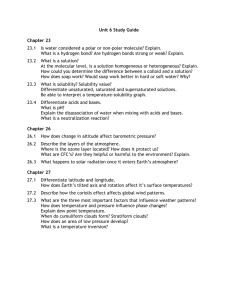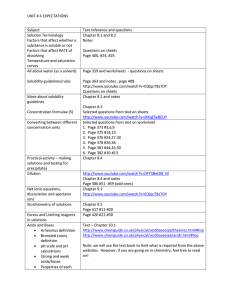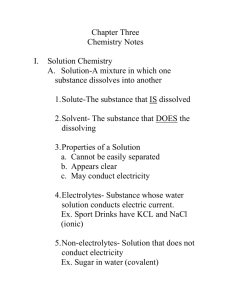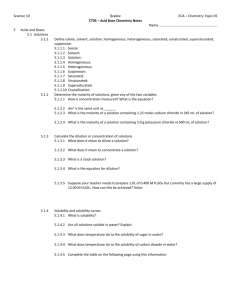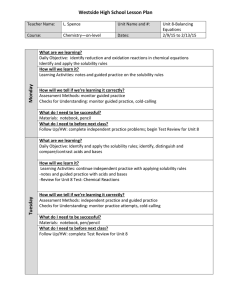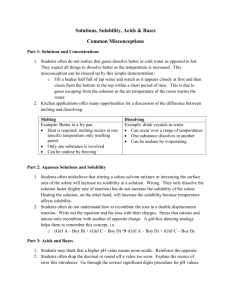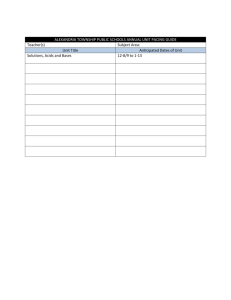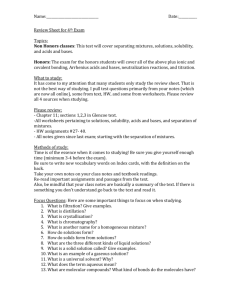SCH3U Solutions and Solubility - OISE-IS-Chemistry-2011-2012
advertisement
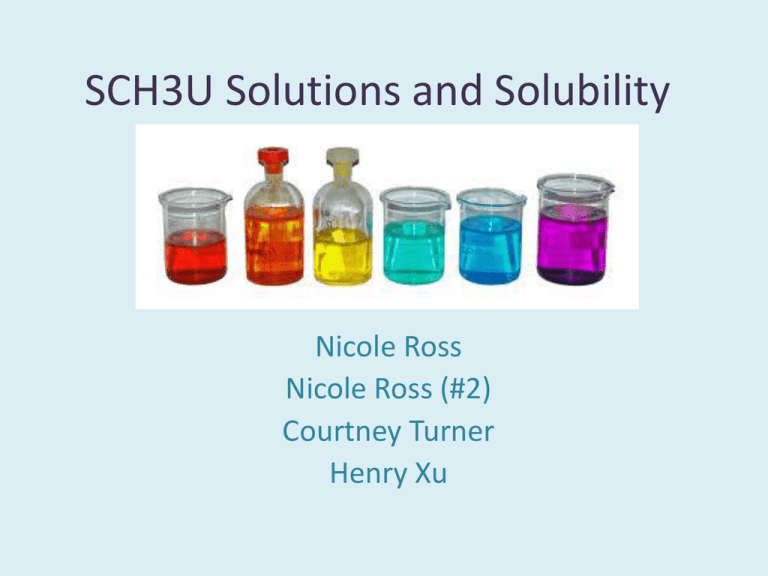
SCH3U Solutions and Solubility Nicole Ross Nicole Ross (#2) Courtney Turner Henry Xu Minds On Activity Agenda • Unit Plan • Big Ideas • Overall and Guiding questions • Blog • Activity • Misconceptions Unit Plan Lesson 1: Intro to Solutions - pre-assessment questions - classifying solutions - testing solubility - properties of solutions Lesson 2: Factors that Affect Solubility - water Lesson 3: LAB for Factors - lab design to test factors - carry out lab - discuss results in groups Lesson 4: Concentration - molarity Lesson 5: Concentration cont. - group work activity - dilutions Lesson 6: Preparing Solutions - flask types and accuracy - mass accuracy - concentration determination Lesson 7: Reactions in Aqueous Solutions - quiz (20 min) - demo Lesson 8: Ionic Equations and Reactions - Lesson 9: Stoichiometry - intro to concept - practice problems - group work Lesson 10: Stoichiometry - applied to solution chemistry - C1V1 = C2V2 Lesson 11: Water - water quality: factors, determination - water pollution Lesson 12: Water - water purification - waste-water treatment Lesson 13: FIELD TRIP to Water Treatment Facility Lesson 14: Filtering - quiz (20 min) - filter activity/lab: design filter, test it Lesson 15: Acids/Bases - pH - demo Lesson 16: Acids/Bases - reactions of - strong acids/bases - weak acids/ bases Lesson 17: Neutralization - reactions - real world examples Lesson 18: LAB for Acids/Bases - Titration Lesson 19: Lesson 20: Unit Test Review/Study day -Jeopardy style review day Big Ideas Properties of solutions can be described qualitatively and quantitatively, and can be predicted People have a responsibility to protect the integrity of Earth’s atmosphere Living things depend for their survival on the unique physical and chemical properties of water Guiding Questions Describe the unique characteristics of water as a solvent. How does acid/base chemistry relate to solutions and solubility? Identify environmental factors, consequences and resolutions of water pollution. Learn about the qualitative and quantitative analysis of solutions including: the solubility table, ion dissociation and polarity. Overarching Question: Describe water as a universal solvent. Identify common contaminants in water (sourcing at least one acid, one base, one ion). Explain their origin, their removal, and their environmental impacts. Check Out Our Blog! http://solutions-and-solubility.blogspot.com/ Activity: Trivia Board Games Common Misconceptions • Students often do not realize that gases dissolve better in cold water as opposed to hot. They expect all things to dissolve better as the temperature is increased. • Stirring a solute-solvent mixture or increasing the surface area of the solute will NOT increase its solubility in a solution. Common Misconceptions • Students may think that a higher pH value means more acidic. Reinforce the opposite. • Reinforce that “concentrated” (having a high concentration of particles in mol/L) is different from “strong” (dissociates 100%), and “dilute” (having a low concentration of particles in mol/L) is different from “weak” (dissociates much less than 100%). Thank You! Questions?
